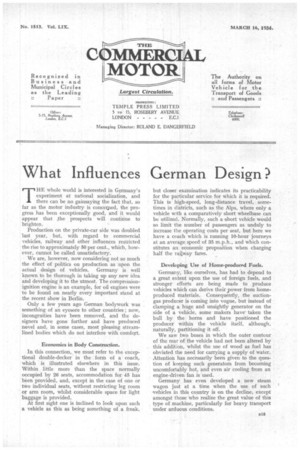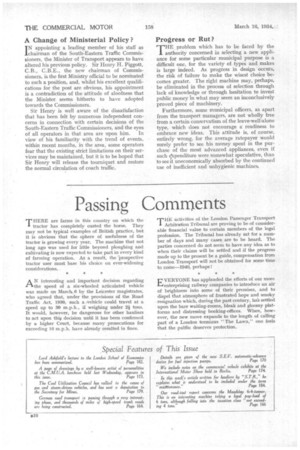What Influences German Design?
Page 25

Page 26

If you've noticed an error in this article please click here to report it so we can fix it.
THE whole world is interested in Germany's experiment at national socialization, and there can be no gainsaying the fact that, so far as the motor industry is concerped, the progress has been exceptionally good, and it would appear that the prospects will continue to brighten.
Production on the private-car side was doubled last year, but, with regard to commercial vehicles, railway and other influences restricted the rise to approximately 50 per cent., which, however, cannot be called unsatisfactory.
We are, however, now considering not so much the effect of politics on production as upon the actual design of vehicles. Germany is well known to be thorough in taking up any new id-ea and developing it to the utmost. The compressionignition engine is an example, for oil engines were to be found on nearly every important stand at the recent show in Berlin.
Only a few years ago German bodywork was something of an eyesore to other countries; now, incongruities have been removed, and the designers have gone further and have produced novel and, in some cases, most pleasing streamlined bodies which do not interfere with comfort.
Economics in Body Construction.
In this connection, we must refer to the exceptional double-decker in the form of a coach, which is illustrated elsewhere in this issue. Within little more than the space normally occupied by 26 seats, accommodation for 45 has been provided, and, except in the case of one or two individual seats, without restricting leg room or arm room, whilst considerable space for light baggage is provided.
At first sight one is inclined to look upon such a vehicle as this as being something of a freak, but closer examination indicates its practicability for the particular service for which it is required. This is high-speed, long-distance travel, sometimes in districts, such as the Alps, where only a vehicle with a comparatively short wheelbase can be utilized. Normally, such a .short vehicle would so limit the number of passengers as unduly to increase the operating costs per seat, but here we have a coach which is running 10-hour journeys at an average speed of 35 m.p.h., and which constitutes an economic proposition when charging half the railway fares.
Developing Use of Home-produced Fuels.
'Germany, like ourselves, has had to depend to a great extent upon the use of foreign fuels, and stronger efforts are being made to produce vehicles which can derive their yower from homeproduced materials. Consequently, the suctiongas producer is coming into vogue, but instead of clamping a huge and unsightly generator on the side of a vehicle, some makers have taken the bull by the horns and have positioned the producer within the vehicle itself, although, naturally, partitioning it off, We saw two buses in which the outer contour of the rear of the vehicle had not been altered by this addition, whilst the use of wood as fuel has obviated the need for carrying a supply of water. Attention has necessarily been given to the question of keeping such generators from becoming uncomfortably hot, and even air cooling from an engine-driven fan is used.
Germany has even developed a new steam wagon just at a time when the use of such -vehicles in this country is on the decline, except amongst those who realize the great value of this type of machine, particularly for heavy transport under arduous conditions. A Change of Ministerial Policy ?
IN appointing a leading member of his staff as chairman of the South-Eastern Traffic Commissioners, the Minister of Transport appears to have altered his previous policy. Sir Henry H. Piggott, CB., C.B.E., the new chairman of Commissioners, is the first Ministry official to be nominated to such a position, and, whilst his excellent qualifications for the post are obvious, his appointment is a contradiction of the attitude of aloofness that the Minister, seems hitherto to have adopted towards the Commissioners.
Sir Henry is well aware of the dissatisfaction that has been felt by numerous independent concerns in connection with certain decisions of the South-Eastern Traffic Commissioners, and the eyes of all operators in that area are upon him. In view of his familiarity with the trend of events, within recent months, in the area, some operators fear that the existing strict limitations on their services may be maintained, but it is to be hoped that Sir Henry will release the tourniquet and restore the normal circulation of coach traffic.
Progress or Rut ?
THE problem which has to be faced by the authority concerned in selecting a new appliance for some particular municipal purpose is a difficult one, for the variety of types and makes is large indeed. As progress in design occurs, the risk of failure to make the wisest choice becornes greater. The right machine may, perhaps, be eliminated in the process of selection through lack of knowledge or through hesitation to invest public money in what may seem an inconclusively proved piece of machinery.
Furthermore, some municipal officers, as apart from the transport managers, are not wholly free from a certain conservatism of the leave-well:alone type, which does not encourage a readiness to embrace new ideas. This attitude is, of course, entirely wrong, for the average ratepayer would surely prefer to see his money spent in the purchase of the most advanced appliances, even if such e:kpenditure were somewhat speculative, than to see it uneconomically absorbed by the continued use of inefficient and unhygienic machines.




















































































